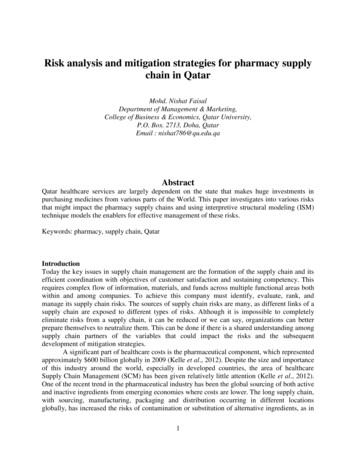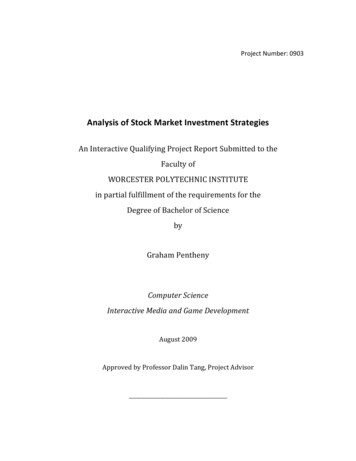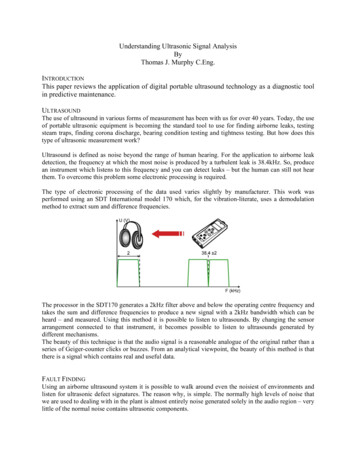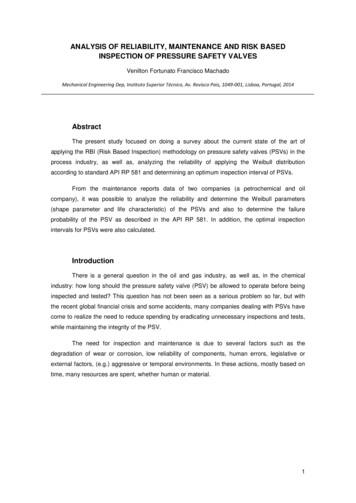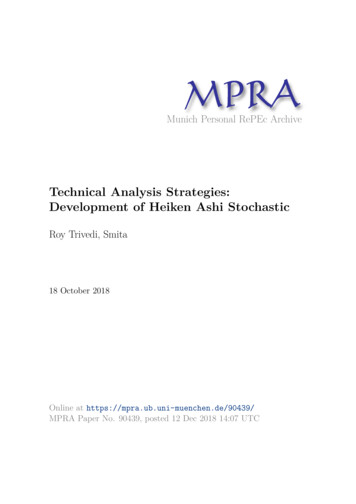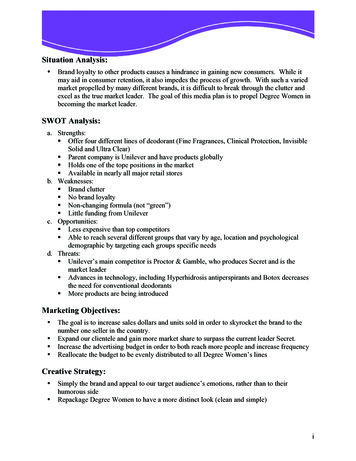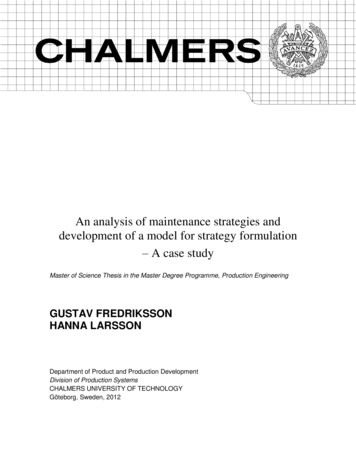
Transcription
An analysis of maintenance strategies anddevelopment of a model for strategy formulation– A case studyMaster of Science Thesis in the Master Degree Programme, Production EngineeringGUSTAV FREDRIKSSONHANNA LARSSONDepartment of Product and Production DevelopmentDivision of Production SystemsCHALMERS UNIVERSITY OF TECHNOLOGYGöteborg, Sweden, 2012
An analysis of maintenance strategies anddevelopment of a model for strategy formulation- A case studyGUSTAV FREDRIKSSONHANNA LARSSONDepartment of Product and Production DevelopmentDivision of Production SystemsCHALMERS UNIVERSITY OF TECHNOLOGYGöteborg, Sweden, 2012
An analysis of maintenance strategies anddevelopment of a model for strategy formulation- A case studyGUSTAV FREDRIKSSONHANNA LARSSON GUSTAV FREDRIKSSON, HANNA LARSSON, 2012Examiner: Johan StahreDepartment of Product and Production DevelopmentChalmers University of TechnologySE-412 96 GöteborgTelephone: 46 (0)31 – 772 10000
ABSTRACTMaintenance has during a long period of time mostly been associated with costs and stoppagesand has, of this reason, acquired a connotation of being something necessary evil. Nowadays,availability, reliability and safety in the production plants are more emphasized. An increasinglynumber of companies replaces the current reactive, fire-fighting, maintenance strategy withproactive strategies such as predictive and preventive maintenance and also with aggressivestrategies such as Total Productive Maintenance (TPM) in order to achieve world-classperformance.This master thesis is aimed to address these issues for Volvo Trucks. Volvo is today working withmaintenance in a reactive manner, where events and failures choose the direction. Although,there are at present ongoing changes in order to become more preventive and proactive in thework. This master thesis should serve as a basis for developing their strategy which will guidethem towards a preventive and proactive maintenance environment.A number of different methods have been used in this master thesis, i.e. a literature study; aninternship with maintenance craftsmen on the shop-floor; a visit at the maintenance fair; animprovement meeting with a cross-functional group and interviews with maintenance craftsmen;benchmarking of Volvo Trucks Tuve and three other companies. A maintenance departmentanalysis (MDA), which is a tool for benchmarking, has also been made. The MDA is a form with 45questions, whose intent is to review and score the maintenance organization within a company.The thesis provides results showing that a highly reactive approach is used by the maintenancedepartment. The average score from the MDA, with a value of 2.2, placed Volvo Trucksmaintenance department last among the benchmarked companies. There is room forimprovements in cooperation and communication between the maintenance department andproduction department, and this will contribute to a more preventive working environment.The maintenance department is often left out of projects and seen as a separate supportingfunction. The benchmarking has proven that successful companies have changed that approachand the communication between departments is integrated. These methods later formed thebasis for the Customer Focused Model which has been developed, to guide Volvo Trucks indeveloping a maintenance strategy.The Customer Focused Model has been developed primarily from the factors the authors found toobstruct the maintenance department from achieving the desired state and thus, it is a guidanceto achieve the desired state. Together with Volvo's expertise and experience within the ownorganization and the area of maintenance it is hoped that the model will function as a bridge whendeveloping and improving the organization to reach the vision.Keywords: Maintenance strategy, reactive maintenance, preventive maintenance, proactivemaintenance, reliability, life cycle costing, change management, human factors.
ACKNOWLEDGEMENTAs a final part of our Master's program, this work was performed during the spring semester of2012 at the Volvo trucks in Gothenburg, Sweden. We would like to say a big thank you to Volvoand in particular the maintenance department for the opportunity to perform this work. A goodattitude along with a large own arrangement and willing cooperation has facilitated andcontributed enormous impact, both to the thesis work but also for our personal development. Anextra mention, we dedicate our tutors Alexander Börjesson and Hans Wall for a big commitmentand that you always have been present during the work.We would also like to thank the organization Sustainability and Maintenance Global Center, SMGC,and Filip Adielsson for the contributions made via knowledge, experience and contacts providedwhich enabled the benchmarking studies we've performed. An organization whose future we hopeto be successful, as they highlights a very important, but also interesting, area that we believe willbe an important factor for companies from now on.Finally, we want to spend the last word to thank our supervisor Torbjörn Ylipää, for his eternalcommitment to our work. Torbjörn has provided us with his extensive knowledge and experiencewhich have contributed a great support to this thesis, and we are eternally grateful for that.Göteborg, June 2012.Gustav FredrikssonHanna Larsson
Table of ContentsABBREVIATIONS . 11 INTRODUCTION . 21.1 Background. 21.2 Purpose . 21.3 Research questions . 31.4 Delimitations . 32 METHOD . 42.1 Literature study . 52.2 Internship on the shop-floor . 52.3 Visit at the maintenance fair . 62.4 Benchmarking . 62.5 Workshop at Volvo Trucks Tuve . 82.6 Interviews with maintenance craftsmen. 82.7 Maintenance Conference . 92.8 Presentation at Volvo Trucks . 102.9 Presentation at SKF – Validation . 102.10 Reliability and validity . 103 THEORETICAL FRAMEWORK . 123.1 The development of Maintenance . 123.2 Maintenance strategy . 143.3 Maintenance Management. 253.4 Maintenance concepts with fundamental ideas . 383.5 Human factors and change management . 704 RESULTS. 754.1 Present state description. 754.2 Maintenance fair, Gothenburg 2012 . 804.3 Benchmarking Tools . 824.4 The results of the benchmarking conducted . 904.5 Improvement meeting – Maintenance . 1064.6 Presentation at Volvo Trucks . 1084.7 Presentation at SKF - Validation . 1095 DISCUSSION . 1105.1 Formulation of a maintenance strategy . 1105.2 Success factors for implementation of the maintenance strategy . 1235.3 Maintenance Department Analysis – MDA and Client Needs Analysis - CNA . 1245.4 Reliability and validity of methods and results . 1256 CONCLUSION . 1277 REFERENCES . 129
APPENDIX I – QUESTIONS SUPPORTING INTERVIEWS WITH MAINTENANCECRAFTSMEN . IAPPENDIX II – PRESERVE SYSTEM FUNCTION . IIAPPENDIX III – MAINTENANCE DEPARTMENT ANALYSIS . IIIAPPENDIX IV – JUSTIFICATION TO QUESTIONS – MDA. XAPPENDIX V – POLAR DIAGRAM FROM CLIENT NEEDS ANALYSIS . XVAPPENDIX VI – PARETO CHART FROM CLIENT NEEDS ANALYSIS . XVI
ABBREVIATIONSBCMBusiness Centered ModelCFMCustomer Focused ModelCMCorrective maintenanceCMMS Computerized maintenance management systemCNAClient Needs AnalysisDoDDepartment of DefenseEEMEarly Equipment ManagementEWOEmergency Work OrderFMEA Failure Mode and Effects AnalysisJIPMJapan institute of plant maintenanceJMAJapan management associationKPIKey Performance IndicatorLCCLife Cycle CostLCPLife Cycle ProfitLTALogic tree analysisMDAMaintenance department analysisMTBF Mean time between failuresMTTF Mean time to failureOEEOverall equipment efficiencyPDCA Plan-Do-Check-ActPdMPredictive maintenancePMPreventive maintenanceRCARoot-cause analysisRCMReliability centered maintenanceROIReturn on investmentSWOT Strengths-Weaknesses-Opportunities-ThreatsSMGC Sustainability and Maintenance Global CenterTPMTotal productive maintenanceWCM World class manufacturing1
1 INTRODUCTIONBelow is the background, purpose, delimitations and research questions, with the intention tohighlight the cause of this work. It is hoped that the reader is presented with the subject and in theend can connect with the conclusions of the work.1.1 BackgroundBefore World War II there was no maintenance as much. Parts were mostly menial and they wouldbreak so they were changed thus removed. An error, therefor, had little effect and was in manycases thus ignored. That changed during the war. Demand for production and productionincreased, but with a lack of manpower it led to more mechanized industry and more complexproduction (Alsyouf, 2007). Cost, longevity and availability were topics that aroused interest, andthus arose maintenance departments. The new found state had maintenance departments todevelop periodic maintenance, planned maintenance and preventive maintenance (Kister andHawking, 2006).A production system consists of different types of equipment; all equipment must have a highavailability and reliability in order to ensure a stable process. The maintenance department isresponsible for keeping the equipment in the condition it initially was procured for and also toensure that it can deliver according to the specification. This is an important role in a productionsystem and if it is performed successfully it can facilitate the journey towards becomingsustainable through high asset utilization, thus providing to the overall profitabilitySuccessful companies of today have often a distinct expressed business idea connected to astrategy that explains it and also, how to reach it.It is widely known that the maintenance currently is viewed by management as a big expense. Andit is not an unusual opinion since maintenance does not include any value adding activities. Butthis is about to change. It is increasingly common for enterprises to work with maintenance as acenter point of profit. A greater knowledge of maintenance and its ability for long term profitinghave increased the interest in the topic. It is all based on minimizing the downtime and the key tosuccess is to ensure that proactive maintenance is properly being used. Hence, by leaving thefirefighting perspective and striving to use proactive maintenance there is a lot to gain. Lessfailure, minimized downtime, lowered stress and higher quality, all working in the favor of profit.1.2 PurposeAs Volvo trucks are trying to achieve a maintenance strategy where preventive maintenanceaccounts for as large part as possible, one has now developed a clear vision for where to be withina reasonable time. Furthermore, to achieve this vision one need to have a strategy which connectspresent time and t
performance. This master thesis is aimed to address these issues for Volvo Trucks. Volvo is today working with maintenance in a reactive manner, where events and failures choose the direction. Although, there are at present ongoing changes in order to become more preventive and proactive in the work. This master thesis should serve as a basis for developing their strategy which will guide them .


